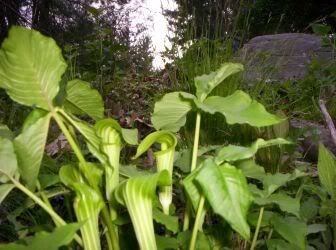
from the Species triphyllum...and the Family: Araceae...goes by many common names. Wild Turnip, Wake Robin, Bog Onion, Dragonroot, Marsh Pepper, Cuckoo Flower, Wood Pulpit and Indian Almond just to name a few. The spadix, which is that little stick like shape inside the leaf, is the "Jack" and the cup shaped leaf that surrounds it is the "pulpit".
I discovered this plant growing on my hillside as I was on my way down to fetch one of my hens up the hill for the evening. At first I was grouchy at the thought of having to walk all the way down to the bottom of the hill after "Whitey". She has not been herself lately, and has taken to lounging in the late afternoon sun at the bottom of the hill, and after all the other hens are tucked in for the night, Whitey is still roosting in the tall grass, reluctant to come when I call her, leaving me with little choice but to go after her and carry her up to the henhouse.
Anyway, on my way down the hill I saw the Jack in the Pulpit and my mood changed.
I have seen Jack growing around here before, but never this type. This one was all green, usually, we see the purple striped ones. If I am correct, I believe this one is known as Swamp Pulpit.
I have seen Jack growing around here before, but never this type. This one was all green, usually, we see the purple striped ones. If I am correct, I believe this one is known as Swamp Pulpit.
I do not know if this is a Jack or Jill, that is, if it is a male or female plant...but I will be watching to see if gets berries in the fall. The male plant has a small hole in the bottom of the spathe or cup, and this is the exit ramp for pollinators. In the female plants, the pollinators are trapped and have no way to get out, and as a result they pollinate all the tiny little flowers on the spadix, and the flowers will turn into green and then bright red berries.
I have also read that this plant contains oxalic acid which can be toxic...however, here is another plant that contains oxalic acid...

But it made a pretty good pie...yum! Rhubarb can be used as a mordant when dyeing wool because of the oxalic acid in the plant, but I have never tried this....yet.



1 comment:
And why haven't you tried this yet...with all the time you have on your hands!! I think we should have a dye day in the fall. We will send out all the wool from Dave and have it made into roving and just spend a day working our way thru a dye book! Can you freeze the rhubarb for use as a mordant later or would that change the chemical composition? It's actually the leaves you use right? We need a big outdoor kitchen for this, with it's own water source and plenty of clothesline to hang the wool from. May have to make it a whole weekend!
Post a Comment